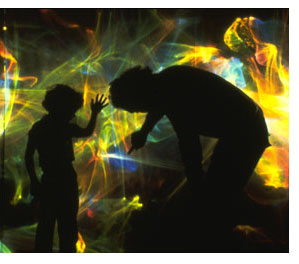BOSTON, Oct. 14 -- The National Science Foundation (NSF) has chosen The Museum of Science, Boston (MoS); the Science Museum of Minnesota and the Exploratorium in San Francisco as the core leadership team for a $20 million, five-year effort to form a national network of science museums and research institutions with the goal of engaging the public's interest in nanotechnology -- technological developments at the level of atoms and molecules that have real world applications. The award to develop the Nanoscale Informal Science Education (NISE) Network is the largest NSF has ever given to the science museum community.
"The nanotechnology field is rapidly evolving, with fundamental advances in physical and life sciences being seen in all areas of our society from medicine to manufacturing, and outcomes with technological, economic, social, environmental and ethical implications that may change our world," said Mihail Roco, key architect of the National Nanotechnology Initiative and senior NSF advisor for nanotechnology. "An increased understanding of nanoscale science and engineering is vital to create an informed citizenry and a competitive workforce for this broad-based technology, and we recognize the substantial role of science museums and other informal science education institutions in pioneering innovative science learning experiences, supplementing K-12 school-based science education and engaging adult audiences."

"Sun Painting," by artist Bob Miller, is shown here during its exhibition at the San Francisco Exploratorium, which is one of the core leaders in the Nanoscale Informal Science Education Network and is famous for giving its visitors a hands-on introduction to science. (Photo: San Francisco Exploratorium)
Leading educators and researchers will closely collaborate on the project. The MoS will both administer the project and focus on the creation of an informal science education media network and adult and older youth education programs with an emphasis on discussion, dialogue and deliberation of the issues raised by the emergence of nanotechnologies. The Science Museum of Minnesota will lead the Network's NISE Center for Exhibit and Program Production and Dissemination, while the Exploratorium will oversee the Center for NISE Research. The first two years of the project will focus on creating the NISE Network and researching the best ways to engage the public in understanding and discussing nanoscale science and engineering themes and perspectives. This will be accomplished through the development of a variety of prototype exhibits, programs, media and professional development activities. The project's second phase, beginning in October 2007, will focus on the production, implementation and dissemination of educational and professional development activities and materials.
Those involved say the NISE Network is not only the first one to address nanotechnology informal education but also is a new way in which NSF is placing its funding to National Nanotechnology Initiative (NNI) centers and networks to be more relevant to society. The NNI is a federal program established to coordinate the efforts of 24 federal agencies in nanoscale research. Nanoscale science and engineering explores revolutionary approaches to producing new kinds of materials, systems and devices through the control and manipulation of matter at the nanoscale (one billionth of a meter). The federal government's current investment in nanotechnology research is expected to lead to far-reaching and beneficial outcomes for healthcare, manufacturing, information processing, defense, construction and transportation, energy production and conservation. These breakthroughs will likely require an overhaul in science and engineering education and will also have economic, environmental, cultural and societal dimensions that will require public input and guidance.
The NISE Network leadership team has set a goal to provide some form of educational materials to 100 informal educational sites by the end of 2010. For more information, visit: www.nsf.gov